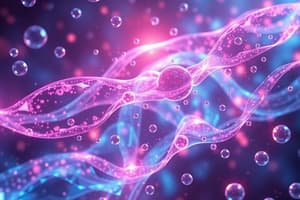Podcast
Questions and Answers
What is primarily responsible for the release of a drug into the body?
What is primarily responsible for the release of a drug into the body?
- Liberation (correct)
- Distribution
- Absorption
- Excretion
Which of the following factors does NOT affect the absorption of a drug?
Which of the following factors does NOT affect the absorption of a drug?
- Metabolism rate (correct)
- pH levels
- Intestinal movement
- Presence of food
In which part of the body are weak bases primarily absorbed?
In which part of the body are weak bases primarily absorbed?
- Liver
- Stomach
- Colon
- Small intestine (correct)
What term describes the relationship between tissue and blood levels of a drug?
What term describes the relationship between tissue and blood levels of a drug?
Which pharmacological parameter is primarily concerned with the removal of drugs from the body?
Which pharmacological parameter is primarily concerned with the removal of drugs from the body?
Which drug classification includes digoxin?
Which drug classification includes digoxin?
What is a common cause of drug toxicity?
What is a common cause of drug toxicity?
Which class of drugs does NOT include a sodium channel blocker?
Which class of drugs does NOT include a sodium channel blocker?
What process involves conversion of a parent drug to its metabolites?
What process involves conversion of a parent drug to its metabolites?
Which electrolyte can influence the therapeutic actions of digoxin?
Which electrolyte can influence the therapeutic actions of digoxin?
Which characteristic qualifies a drug for therapeutic drug monitoring?
Which characteristic qualifies a drug for therapeutic drug monitoring?
What is the primary purpose of therapeutic drug monitoring?
What is the primary purpose of therapeutic drug monitoring?
What differentiates trough concentration from peak concentration?
What differentiates trough concentration from peak concentration?
Which statement accurately reflects the relationship between drug dosage and circulating concentrations in TDM?
Which statement accurately reflects the relationship between drug dosage and circulating concentrations in TDM?
Which route of administration is associated with 100% bioavailability?
Which route of administration is associated with 100% bioavailability?
What role does the mixed function oxidase (MFO) system play in drug metabolism?
What role does the mixed function oxidase (MFO) system play in drug metabolism?
Why is it important to monitor patient compliance in TDM?
Why is it important to monitor patient compliance in TDM?
What happens to the half-life of a drug when the physiological state of a patient changes significantly?
What happens to the half-life of a drug when the physiological state of a patient changes significantly?
Which of the following is NOT an objective of therapeutic drug monitoring?
Which of the following is NOT an objective of therapeutic drug monitoring?
What is typically the result of both overdosing and underdosing a therapeutic drug?
What is typically the result of both overdosing and underdosing a therapeutic drug?
Flashcards are hidden until you start studying
Study Notes
Pharmacological Parameters Affecting Serum Drug Concentration
- Liberation: Release of the drug from its formulation.
- Absorption: Transport of drug from administration site to blood; primarily via passive diffusion in a non-ionized state.
- Distribution: Delivery of drug to tissues, often achieving higher concentrations in tissues compared to blood.
- Metabolism: Chemical modification of the drug, primarily occurring in the liver via cytochrome P450 enzymes.
- Excretion: Removal of the drug and metabolites from the body, either unchanged in urine or as metabolites.
Absorption
- Therapeutic doses require appropriate concentration at the site of action.
- Tablets and capsules need to dissolve before absorption, while liquids are absorbed rapidly.
- Weak acids are absorbed in the stomach; weak bases in the intestine.
- Factors affecting absorption include intestinal movement, pH, inflammation, and presence of food or drugs.
Distribution
- Effective drug locations are primarily tissue-based, not bloodstream-centered.
- Distribution space reflects the extent of drug movement into tissues versus staying in circulation.
Excretion
- Drug clearance from circulation depends on drug type and patient's metabolic capacity.
- All drugs are ultimately excreted, either unchanged or as metabolites.
- Some drugs can re-enter the enterohepatic circulation and are excreted in stool.
Causes of Drug Toxicity
- High levels of free drug concentration in the bloodstream.
- Abnormal drug response post-administration.
- Active drug metabolites contributing to adverse effects.
Cardioactive Drugs
- Used to treat cardiac conditions like arrhythmias and CHF.
- Class I: Rapid sodium channel blockers (e.g., Quinidine, Procainamide, Lidocaine).
- Class II: Beta receptor blockers (e.g., Propranolol).
- Class III: Potassium channel blockers (e.g., Amiodarone).
- Class IV: Calcium channel blockers (e.g., Verapamil).
- Digoxin: Cardiac glycoside for atrial arrhythmia and CHF; serum electrolytes influence its effects and toxicity.
Therapeutic Drug Monitoring (TDM)
- Aims to optimize therapeutic benefit while minimizing side effects by maintaining consistent drug serum levels.
- Relevant for drugs with narrow therapeutic indices and those with poor dose-concentration correlation.
- TDM involves assessing drug concentrations in serum, plasma, or whole blood.
Indications for TDM
- Serious consequences from overdosing or underdosing.
- Small difference between therapeutic and toxic dosages.
- Changes in patient physiology affecting drug concentrations.
- Potential for drug interactions.
- To monitor patient adherence to treatment.
Routes of Drug Administration
- Circulatory system provides effective drug delivery to target sites.
- Intravenous Administration: 100% bioavailability; immediate effect.
- Oral bioavailability is approximately 0.7; has larger variability.
- Other routes include intramuscular, subcutaneous, inhalation, suppository, and transcutaneous.
Studying That Suits You
Use AI to generate personalized quizzes and flashcards to suit your learning preferences.




